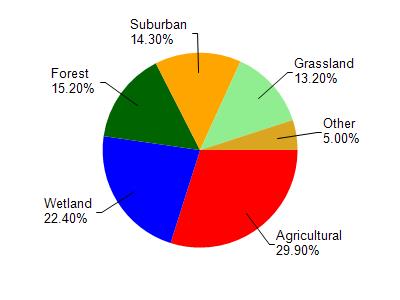Waukesha
No
No
No
Fish and Aquatic Life
Overview
Upper Nashotah Lake, a high quality lake, has no lake management organization or volunteer monitoring. There are some conservancy areas around the lake's shoreline and dredging permit requests were made in 1995.
Date 2002
Author Aquatic Biologist
Historical Description
Source: 1963, Surface Water Resources of Waukesha County Upper Nashotah Lake T7N, R17E, Section 12
The uppermost of a chain of four lakes bordering terminal moraine and outwash deposits. This chain parallels the interlobate moraine. The lake has no inlet and a seasonal outlet flowing to Lower Nashotah Lake. The outlet was impounded in 1925 and maintains a water level difference of about two feet. The water is exceptionally clear and the bottom is mostly sand or gravel. The fishery consists of largemouth bass, pan fish and northern pike. Public access is limited to a county highway without parking on the south shore. Commercial facilities are not available. Rollers are installed in the dam facilitating portaging of boats from Lower Nashotah. A seminary owns about 50 per cent of the shore line. Wetlands are limited to a very small sedge marsh near the outlet.
Surface Acres = 133, S.D.F. = 1.42, Maximum Depth = 53 feet
Date 1963
Author Surface Water Inventory Of Wisconsin
Condition
Wisconsin has over 84,000 miles of streams, 15,000 lakes and milllions of acres of wetlands. Assessing the condition of this vast amount of water is challenging. The state's water monitoring program uses a media-based, cross-program approach to analyze water condition. An updated monitoring strategy (2015-2020) is now available. Compliance with Clean Water Act fishable, swimmable standards are located in the Executive Summary of Water Condition in 2018. See also the 'monitoring and projects' tab.
Reports
Recommendations
Shoreland Ordinance
The Village of Summit intends to update the existing shoreland ordinance to meet the revised standards of NR 115. The Village is proposing to create a separate Village floodplain ordinance. The Village is also proposing to combine the shoreland ordinance and current Village zoning code.
Management Goals
Wisconsin's Water Quality Standards provide qualitative and quantitative goals for waters that are protective of Fishable, Swimmable conditions [Learn more]. Waters that do not meet water quality standards are considered impaired and restoration actions are planned and carried out until the water is once again fishable and swimmable
Management goals can include creation or implementation of a Total Maximum Daily Load analysis, a Nine Key Element Plan, or other restoration work, education and outreach and more. If specific recommendations exist for this water, they will be displayed below online.
Monitoring
Monitoring the condition of a river, stream, or lake includes gathering physical, chemical, biological, and habitat data. Comprehensive studies often gather all these parameters in great detail, while lighter assessment events will involve sampling physical, chemical and biological data such as macroinvertebrates. Aquatic macroinvertebrates and fish communities integrate watershed or catchment condition, providing great insight into overall ecosystem health. Chemical and habitat parameters tell researchers more about human induced problems including contaminated runoff, point source dischargers, or habitat issues that foster or limit the potential of aquatic communities to thrive in a given area. Wisconsin's Water Monitoring Strategy was recenty updated.
Grants and Management Projects
Monitoring Projects
| WBIC | Official Waterbody Name | Station ID | Station Name | Earliest Fieldwork Date | Latest Fieldwork Date | View Station | View Data |
|---|
| 827500 | Upper Nashotah Lake | 10007244 | Upper Nashotah Lake | 6/1/1995 | 8/4/2022 | Map | Data |
| 827500 | Upper Nashotah Lake | 683131 | Upper Nashotah Lake - (Inlet) | 11/19/1973 | 4/22/1975 | Map | Data |
| 827500 | Upper Nashotah Lake | 683132 | Upper Nashotah Lake - Deep Hole | 11/19/1973 | 6/22/1995 | Map | Data |
|

Watershed Characteristics
Upper Nashotah Lake is located in the Bark River watershed which is 185.84 mi². Land use in the watershed is primarily agricultural (29.90%), wetland (22.40%) and a mix of forest (15.20%) and other uses (32.50%). This watershed has 265.69 stream miles, 3,499.26 lake acres and 22,145.94 wetland acres.
Nonpoint Source Characteristics
This watershed is ranked Medium for runoff impacts on streams, High for runoff impacts on lakes and High for runoff impacts on groundwater and therefore has an overall rank of High. This value can be used in ranking the watershed or individual waterbodies for grant funding under state and county programs.However, all waters are affected by diffuse pollutant sources regardless of initial water quality. Applications for specific runoff projects under state or county grant programs may be pursued. For more information, go to surface water program grants.